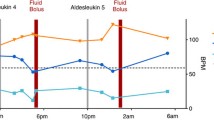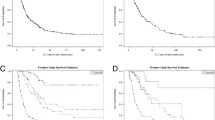Summary
Recombinant interleukin-2 (rIL-2) modified with monomethoxypolyethylene glycol (PEG IL-2) was utilized in patients with metastatic renal cell carcinoma in two separate multi-institutional trials. PEG IL-2 was administered as an I.V. bolus days 1, 8, 15, and 22 with cycles repeated every six weeks. The two trials employed different dose levels: A) 20x106 I.U./m2 day 1 followed by 12x106 I.U./m2 days 8, 15, 22; and B) 12x106 I.U./m2 days 1, 8, 15, 22. Thirty-five patients were entered and 31 were evaluable for response (A−15/18, B−16/17). Two of 31 patients had partial responses. Median therapy duration was four weeks (range 1–15), and dose reduction for grade III or IV toxicity was required in 14/35 patients (A-6/18, B-8/17). Toxicity (≥ grade III) seen included: hypotension 51%, dyspnea 17%, seizures 6%, and mental status changes 11%. No differences in response or toxicity between the two schedules were noted. Hematologic changes included lymphocytosis and eosinophilia in the majority of patients. PEG IL-2 given once weekly has significant toxicity, and may produce tumor regression in patients with renal cell carinoma.
Similar content being viewed by others
References
Grimm EA, Mazumder A, Zhang HZ, Rosenberg SA: Lymphokine-activated killer cell phenomenon. Lysis of natural killer-resistant fresh solid tumor cells by interleukin-2 activated autologous human peripheral blood lymphocytes. J Exp Med 155:1823–1841, 1982
Rosenberg SA, Grimm EA, McGrogan M, Doyle M, Kawasaki E, Koaths K, Mark DF: Biological activity of recombinant human interleukin-2 produced in Escherichia coli. Science 223:1412–1414, 1984
Talmadge JE, Philips H, Schindler J, Tribble H, Pennington R: Systematic preclinical study on the therapeutic roperties of recombinant human interleukin-2 for the treatment of metastatic disease. Cancer Res 47:5725–5732, 1987
Rosenberg SA, Lotze MT, Muul LM, Chang AE, Avis FP, Leitman S, Linehan WM, Robertson CN, Lee RE, Rubin JT: A progress report on the treatment of 157 patients with advanced cancer using lymphokine-activated killer cells and interleukin-2 on high-dose interleukin-2 alone. N Engl J Med 316:889–897, 1987
Rosenberg SA, Lotze MT, Yang JC, Aebersold PM, Linehan WM, Seipp CA, White DE: Experience with the use of high-dose interleukin-2 in the treatment of 652 cancer patients. Ann Surg 210:474–485, 1989
West WH, Tauer KW, Yanelli JR, Marshall GD, Orr DW, Thurman GB, Oldham RK: Constant infusion recombinant interleukin-2 in adoptive immunotherapy of advanced ancer. N Engl J Med 316:898–905, 1987
Bradley EC, Louie AC, Paradise CM, Carlin DA, Bleyl KL, Groves ES, Rudolph AR: Antitumor response in patients ith metastatic renal cell carcinoma is dependent upon regimen ntensity. Proc Am Soc Clin Oncology 8:A519, 1989
Knauf MJ, Bell DP, Hirtzer P, Luo ZP, Young JD, Katre NV: Relationship of effective molecular size to systemic learance in rats of recombinant interleukin-2 chemically modified with water soluble polymers. J Biol Chem 263:15064–15070, 1988
Katre NV, Knauf MJ, Laird WJ: Chemical modification of recombinant interleukin-2 by polyethylene glycol increases it potency in the murine Meth A sarcoma model. Proc Natl Acad Sci USA, 84:1487–1491, 1987
Zimmerman RJ, Aukerman SL, Katre NV, Winkelhake JL, Young JD: Schedule dependency of the antitumor activity and toxicity of polyethylene glycol-modified interleukin-2 in murine tumor models. Cancer Res 49:6521–6528, 1989
Meyers FJ, Paradise C, Scudder SA, Goodman G, Konrad M: A phase I study including pharmacokinetics of polyethyline glycol conjugated interleukin-2. Clin Pharmacol Ther 49:307–313, 1991
Schwartzberg L, West W, Fyfe G, Tauer K, Zimmerman R, Arnold J: A Phase I study of recombinant interleukin-2 (rIL-2) in advanced malignancy: modification of dosing to stimulate the pharmacokinetics of polyethylene glycolmodified rIL-2 (PEG IL-2). Proc Soc Clin Oncol 10:A241, 1991
Sondel PM, Kohler PC, Hank JA, Moore KH, Rosenthal NK, Sosman JA, Bechhofer R, Storer B: Clinical and immunological effects of recombinant interleukin-2 given by repetitive weekly cycles to patients with cancer. Cancer Res 48:2561–2567, 1988
Thompson JA, Lee DJ, Lindgren CG, Benz LA, Collins C, Levitt D, Fofer A: Influence of dose and duration of infusion of interleukin-2 on toxicity and immunomodulation. Jrn of Clin Onc 6:669–678, 1988
Finke JH, Tubbs R, Connelly R, Pontes E, Monti J: Tumorinfiltrating lymphocytes in patients with renal cell carcinoma. Annals of the NY Acad of Sci 532:387–394, 1988
Author information
Authors and Affiliations
Rights and permissions
About this article
Cite this article
Bukowski, R.M., Young, J., Goodman, G. et al. Polyethylene glycol conjugated interleukin-2: Clinical and immunologic effects in patients with advanced renal cell carcinoma. Invest New Drugs 11, 211–217 (1993). https://doi.org/10.1007/BF00874158
Issue Date:
DOI: https://doi.org/10.1007/BF00874158




